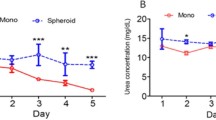Abstract
Primary human fetal hepatocytes proliferated in monolayer culture up to the 9th passage. During proliferation, the cells changed their morphology from a fibroblast-like shape after inoculation to an epithelia-like polygonal shape after they reached confluence. The proliferation was associated with the loss of ammonia detoxification capacity, which is essential for the function of bioartificial liver. The cells formed spheroids on a poly-glutamic acid- or poly-aspartic acid-coated polystyrene dish that had a negatively charged surface at neutral pH. However, the cells did not form spheroids on a poly-lysine- or poly-arginine-coated dish that had a positively charged surface, which is reportedly suitable to form spheroids for adult hepatocytes. The activity of cytochrome P450 (CYP 1A1, CYP1A2) of the cells in spheroid culture was about twice as high as that of the cells in monolayer culture. The ammonia detoxification activity of the cells was restored in spheroid culture by treatment with 2% dimethylsulfoxide. These results suggest that the conditions for human fetal hepatocytes to form spheroids are different from that for adult hepatocytes, and the use of poly-glutamic acid or poly-aspartic acid coating may improve spheroid culture of proliferative human fetal hepatocytes.
Similar content being viewed by others
References
Cretton E.M. and Sommadossi J.P. 1991. Modulation of 30-Azido-30-eoxythymidine catabolism by probenecid and acetaminophen in freshly isolated rat hepatocytes. Biochem. Pharmacol. 42: 1475–1480.
Enosawa S., Suzuki S., Kakefuda T. and Amemiya H. 1996. Examination of 7-ethoxycoumarin deethylation and ammonia removal activities in 31 hepatocyte cell lines. Cell Transplant. 5: 39–40.
Gerlach J.C. 1996. Development of a hybrid liver support system: a review. Int. J. Artif. Organs 19: 645–654.
Germain L., Blouin M.J. and Marceau N. 1988. Biliary epithelial and hepatocytic cell lineage relationships in embryonic rat liver as determined by the differential expression of cytokeratins, alpha-fetoprotein, albumin, and cell surface-exposed components. Cancer Res. 48: 4909–4918.
Grisham J.W. and Thorgeirsson S.S. 1997. Liver stem cells. In: Potten C.S. (ed.), Stem Cells, Academic Press, San Diego, pp. 233–282.
Ijima H., Matsushita T., Nakazawa K., Fujii Y. and Funatsu K. 1998. Hepatocyte spheroids in polyurethane foams: functional analysis and application for a hybrid artificial liver. Tissue Eng. 4: 213–226.
Karikusa F. and Sawasaki Y. 1996. The restoration of the functions of serially passaged calf hepatocytes by spheroid formation. In Vitro Cell. Dev. Biol. 32: 30–37.
Khalil M., Shariat-Panahi A., Tootle R., Ryder T., McCloskey P., Roberts E., Hodgson H. and Selden C. 2001. Human hepatocyte cell lines proliferating as cohesive spheroid colonies in alginate markedly upregulate both synthetic and detoxificatory liver function. J. Hepatology 297: 68–77.
Koide N., Sakaguchi K., Koide Y., Asano K., Kawaguchi M., Matsushima H., Takenami T., Shinji T., Mori M. and Tsuji T. 1990. Formation of multicellular spheroids composed of adult rat hepatocytes in dishes with positively charged surfaces and under other non-adherent environments. Exp. Cell Res. 186: 227–235.
Kost D.P. and Michalopoulos G.K. 1991. Effect of 2% dimethyl sulfoxide on the mitogenic properties of epidermal growth factor and hepatocytes growth factor in primary hepatocyte culture. J. Cell. Physiol. 147: 274–280.
Landry J., Bernier D., Ouellet C., Goyette R. and Marceau N. 1985. Spheroidal aggregate culture of rat liver cells: histotypic reorganization, biomatrix deposition, and maintenance of functional activities. J. Cell Biol. 101: 914–923.
Le Tissier P., Stoye J.P., Takeuchi Y., Patience C. and Weiss R.A. 1997. Two sets of human-tropic retrovirus (letter). Nature 389: 681–682.
Lubet R.A., Nims R.W., Mayer R.T., Cameron J.W. and Schechtman L.M. 1985. Measurement of cytochrome P-450 dependent dealkylation of alkoxyphenoxazones in hepatic S9s and hepatocyte homogenates: effects of dicumarol. Mutat. Res. 142: 127–131.
Matsushita T., Ijima H., Koide N. and Funatsu K. 1991. High albumin production by multicellular spheroids of adult rat hepatocytes formed in the pores of polyurethane foam. Appl. Microbiol. Biotechnol. 36: 324–326.
Mitaka T., Kojima T., Mizuguchi T. and Mochizuki Y. 1995. Growth and maturation of small hepatocytes isolated from adult rat liver. Biochem. Biophys. Res. Commun. 214: 310–317.
Okey A.B., Roberts E.A., Harper P.A. and Denison M.S. 1986. Induction of drug-metabolizing enzyme: mechanisms and consequences. Clin. Biochem. 19: 132–141.
Patience C., Takeuchi Y. and Weiss R.A. 1999. Infection of human cells by an endogenous retrovirus of pigs. Nat. Med. 5: 282–286.
Sakai Y., Naruse K., Nagashima I., Muto T. and Suzuki M. 1996. Large-scale preparation and function of porcine hepatocyte spheroids. Int. J. Artif. Organs 19: 294–301.
Tateno C., Takai-Kajihara K., Yamasaki C., Sato H. and Yoshizato K. 2000. Heterogeneity of growth potential of adult rat hepatocytes in vitro. Hepatology 31: 65–74.
Tzanakakis E.S., Hsiao C.-C., Matsushita T., Remmel R.P. and Hu W.-S. 2001. Probing enhanced cytochrome P450 2B1/2 activity in rat hepatocytes spheroids through confocal laser scanning microscopy. Cell Transplant. 10: 329–342.
Watanabe F.D., Mullon C.J., Hewitt W.R., Arkadopoulos N., Kahaku E., Eguchi S., Khalili T., Arnaut W., Shackleton C.R., Rozga J., Solomon B. and Demetriou A.A. 1997. Clinical experience with a bioartificial liver in the treatment of severe liver failure: a phase I clinical study. Ann. Surg. 225: 484–494.
Yamashita Y., Shimada M., Tsujita E., Tanaka S., Ijima H., Nakazawa K., Sakiyama R., Fukuda J., Ueda T., Funatsu K. and Sugimachi K. 2001. Polyurethane foam/spheroid culture system using human hepatoblastoma cell line (HepG2) as a possible new hybrid artificial liver. Cell Transplant. 10: 717–72.
Yoon J.H., Lee H.V.-S., Lee J.S., Park J.B. and Kim C.Y. 1999. Development of a non-transformed human liver cell line with differentiated-hepatocyte and urea-synthetic functions: applicable for bioartificial liver. Int. J. Artif. Organs 22: 769–777.
Author information
Authors and Affiliations
Corresponding author
Rights and permissions
About this article
Cite this article
Matsushita, T., Nakano, K., Nishikura, Y. et al. Spheroid formation and functional restoration of human fetal hepatocytes on poly-amino acid-coated dishes after serial proliferation. Cytotechnology 42, 57–66 (2003). https://doi.org/10.1023/B:CYTO.0000009819.28689.42
Issue Date:
DOI: https://doi.org/10.1023/B:CYTO.0000009819.28689.42




